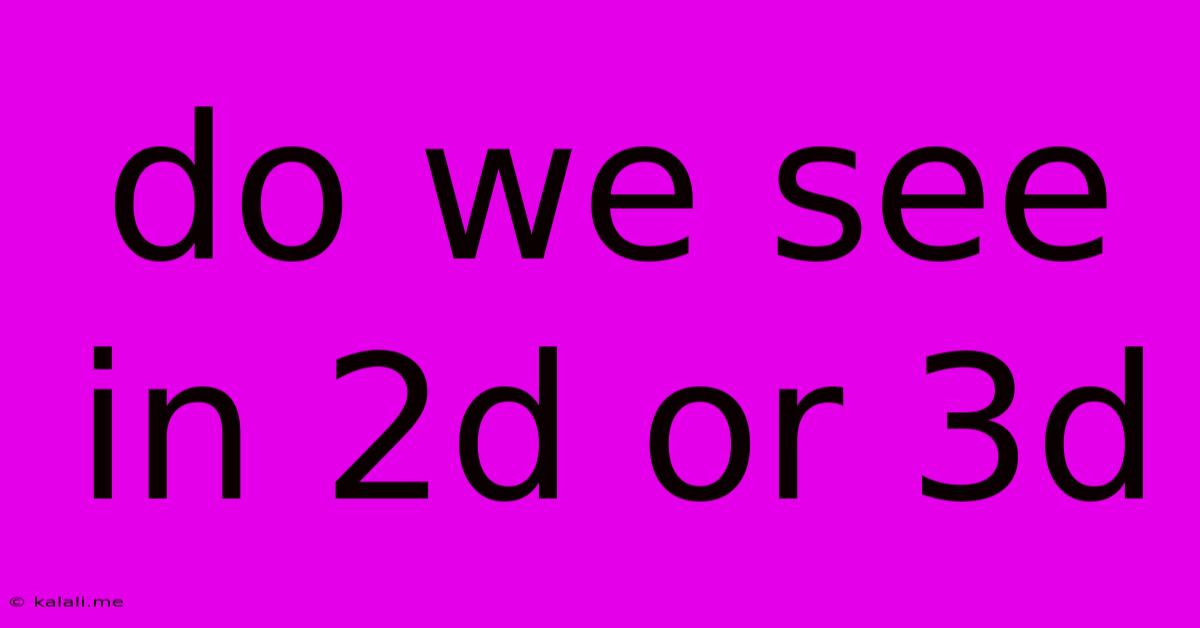Do We See In 2d Or 3d
Kalali
Jun 05, 2025 · 3 min read

Table of Contents
Do We See in 2D or 3D? Unraveling the Mystery of Depth Perception
Meta Description: Explore the fascinating question of whether we perceive the world in 2D or 3D. This article delves into the complexities of depth perception, binocular vision, and monocular cues, explaining how our brains construct a three-dimensional understanding of our surroundings.
We all navigate a seemingly three-dimensional world. We judge distances, avoid obstacles, and appreciate the beauty of sculpted forms. But the images that fall on our retinas are fundamentally two-dimensional. So, do we truly see in 2D or 3D? The answer is more nuanced than a simple yes or no. While the images projected onto our eyes are flat, our brains perform incredible feats of processing to create a rich, three-dimensional experience.
The Role of Binocular Vision
One key component of our 3D perception is binocular vision, the use of both eyes. Because our eyes are slightly separated, each receives a slightly different view of the world. This difference, known as binocular disparity, provides crucial information about depth. Our brains effortlessly compare these two images, calculating the distance of objects based on the degree of disparity. The greater the difference between the images, the closer the object. Think about holding a finger in front of your face and alternately closing each eye – you'll notice a significant shift in your finger's apparent position relative to the background. This is binocular disparity in action.
This process is especially effective for objects relatively close to us. However, for objects further away, binocular disparity becomes less pronounced, and our brains rely on other cues to perceive depth.
Monocular Cues: The Brain's Clever Tricks
Even with one eye closed, we can still perceive depth, albeit with less precision. This is thanks to monocular cues, a variety of visual information that our brains use to infer depth. These cues include:
- Relative Size: We instinctively understand that smaller objects are usually further away than larger objects of the same type.
- Linear Perspective: Parallel lines appear to converge in the distance, creating the illusion of depth. Think of railroad tracks receding into the horizon.
- Interposition (Occlusion): When one object partially obscures another, we perceive the occluded object as being further away.
- Texture Gradient: The density of detail in a surface changes with distance. A textured surface will appear more detailed close up and gradually less detailed as it recedes.
- Atmospheric Perspective: Distant objects often appear hazy or bluish due to atmospheric particles scattering light.
- Motion Parallax: As we move, objects at different distances appear to move at different speeds. Closer objects move faster across our field of vision than distant ones. This is especially noticeable when driving.
The Construction of 3D Perception: A Collaborative Effort
Our perception of depth isn't simply a passive reception of 3D information; it's an active construction. Our brains integrate binocular disparity and numerous monocular cues, along with our prior knowledge and experience, to create a cohesive and realistic 3D representation of our environment. This complex process is remarkably efficient, allowing us to navigate and interact with the world with ease.
Conclusion: We See in 3D, But It's a Brain-Built Illusion
While the raw sensory input is 2D, our visual system cleverly constructs a three-dimensional understanding of the world. This ability to perceive depth is crucial for survival and profoundly shapes our experience of reality. The answer, therefore, isn't simply 2D or 3D, but rather a sophisticated combination of both, where the brain plays a crucial role in transforming flat images into a rich, three-dimensional world.
Latest Posts
Latest Posts
-
How To Get Out Of Power Armor
Jun 06, 2025
-
Is It Pot Ential Job Opportotnity Or Job Opportunity
Jun 06, 2025
-
App Not Installed As Package Conflicts With An Existing Package
Jun 06, 2025
-
Can An Anaconda Eat A Human
Jun 06, 2025
-
Which Soldering Iron Tip To Use For Wires
Jun 06, 2025
Related Post
Thank you for visiting our website which covers about Do We See In 2d Or 3d . We hope the information provided has been useful to you. Feel free to contact us if you have any questions or need further assistance. See you next time and don't miss to bookmark.